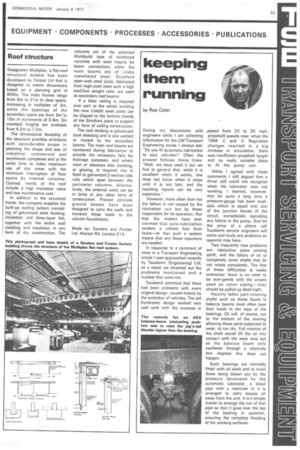keeping them running
Page 57

If you've noticed an error in this article please click here to report it so we can fix it.
by Ron Cater During my discussions with engineers while I am collecting information for the CM Transport Engineering series I always ask: "Do you fit automatic lubrication to your vehicles?" Often the answer follows these lines: "Well, we have used it but we find in general that, while it is excellent when it works, one does not know when it stops until it is too late; and the resulting repairs can be very expensive."
However, more often than not the failure is not caused by the lubrication unit but by those responsible for its operation. Not that the makers have ever claimed that auto-lubrication renders a vehicle free from faults—or that such a system means that any fewer injections are needed.
In response to a comment of mine in a Transport Engineering article I was approached recently by Tecalemit (Engineering) Ltd; as a result we thrashed out the problems mentioned and a number that were not.
Tecalemit admitted that there had been problems with every original design, caused mainly by the evolution of vehicles. The old Syndromic design worked very well until with the increase in
:speed from 20 to 30 mph, propshaft speeds rose; when the 1964 C and U Regulation changes resulted in a big increase in articulation, there was insufficient propshaft length and no really suitable place to fit the pump unit.
While I agreed with these comments I still argued that a driver still could not recognize when his lubricator was not working. I learned, however, that for quite a long time a pressure-gauge has been available which is piped into one of the junction blocks of the circuit, immediately signalling any failure in the pump. And for the price of a phone call Tecalemit service engineers will come and study any problems an operator may have.
Two frequently new problems are: lubrication pipes coming adrift, and the failure of oil to completely cover shafts that do not rotate completely. The first of these difficulties is easily overcome: there is no need to be over-gentle with the unions used on nylon piping---they should be pulled up dead tight.
Heavily laden part-rotating shafts such as those found in balance beams most often bear their loads in the tops of the bearings. Oil will, of course, run to the bottom of the bearing allowing these parts subjected to wear, to run dry. Full rotation of the shaft would lift the oil into contact with the wear area but as the balance beam only oscillates through a relatively few degrees this does not happen.
Such bearings are normally fitted with oil seals and to avoid these being blown out by the pressure developed by the automatic lubricator,, a bleed pipe with a restrictor in it is arranged to carry excess oil away from the unit. It is a simple matter to arrange the run of that pipe so that it goes over the top of the bearing in question, ensuring the complete flooding of the working surfaces.












































































































































